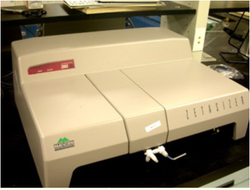Zetasizer 3000Hs (Malvern)
The determination of the zeta potential is performed by first measuring the electrophoretic mobility of dispersed particles and then converting that value to zeta potential by applying electrokinetic theory. The mobility of colloids depend on the characteristics of the solute (electric charge, molecular size and shape) and those of the buffer (type and ionic strength of the electrolyte, pH, viscosity and additives) in which the movement, under influence of an applied current, takes place.
The zeta potential of the sample will determine whether the particles within a liquid will tend to flocculate or not. So, with the measurement of zeta potential in relation to other variables the repulsion between charged particles is indicated and therefore the stability of the colloidal system can be quantified. For example:
- In waste water treatment applications the flocculation state of waste water is altered by changes in pH, the addition of chemical flocculants (such as charged polymers) and the presence of aluminium chloride or other highly charged salts. Measurement of zeta potential incombination with these parameters is fundamental in the development and maintenance of optimized water treatment protocols.
- Regarding emulsions the zeta potential is used to study the chemistry involved in determining whether or not an emulsion will remain stable in the environment where it will be used.
The main advantage of using the Zetasizer 3000HS instead of the Zetasizer IIc is the ability to analyze more diluted samples or more concentrated samples with lower scattering intensity particles.
